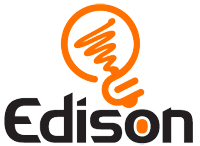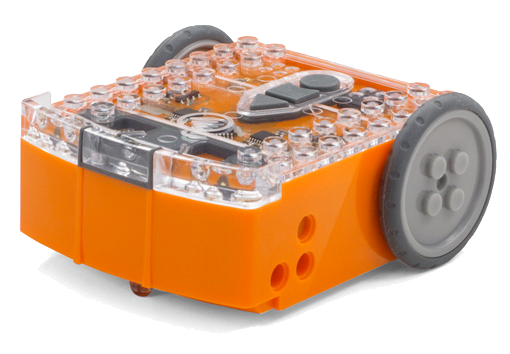EdBlocks programming language
EdBlocks is a fully graphical robot programming language for the Edison robot that is super easy to use. A drag-and-drop block-based system, EdBlocks is intuitive and fun, even for younger users. Perfect for introducing anyone to programming, EdBlocks is ideal for students aged 8 to 12 years old.
The online EdBlocks programming environment is simple to use on both computers and tablets. EdBlocks contains more than 150 blocks, making it easy to experiment with programming. All the blocks are accessible through the main menu, organised into five different categories. Simply open one of the menus by clicking on it in the app, then select the block you want. Drag and drop each block to the ‘start’ block in the main programming area to add it to your program. It’s that easy!
You can access EdBlocks online at www.edblocksapp.com
Lesson activity worksheets
The EdBlocks activity worksheets are designed to allow students to work through activities independently, gradually learning about both the Edison robot and EdBlocks. This set of 23 lesson activities is perfect for students in year levels 3 to 6.
Teacher’s guide to EdBlocks
This guide offers teachers and instructors overviews, activity extensions and other supporting information for the EdBlocks lesson activities to help make teaching EdBlocks easy and fun. Each EdBlocks activity is included in this guide along with any relevant supporting information for that activity.
Curriculum linking guide
This resource serves as a guide as to how the EdBlocks lesson activities to link to standards and requirements in the Australian Curriculum (v8.3).
Download the EdBlocks curriculum linking guide
EdBlocks block guide
Need an offline reference to the blocks in EdBlocks? This guide includes images of the blocks in EdBlocks and the tooltip helper text for each block from the online application.
Download the EdBlocks block guide
Download the EdBlocks easy reference guide (developed by Ian Smith of STEMgoals)
EdBlocks programming projects with EdCreate
Give your students the opportunities to program solutions to real-world robotic challenges using EdBlocks and EdCreate, the Edison robot creator’s kit. Multiple programming challenges perfect for EdBlocks using the EdCreate EdBuilds are available in the EdCreate teaching guide. Or unlock your student’s creativity and EdBlocks programming prowess with the EdCreate EdChallenges!
Additional resources
Translation kits, translated versions and more.
- Example code for the barcode programs in EdBlocks
Looking for more ideas on what to teach with EdBlocks? Check out these articles:
Licenced under Creative Commons – use, adapt and share
We want to make robotics and computer science education available to everyone, which is why these teaching resources have been released under a Creative Commons licence. You are free to use these resources as they are, translate them, share them or use them as the base to develop your own customised lessons.

The EdBlocks Lesson Activities Collection by Emma Dewar and Kat Kennewell is licensed under a Creative Commons Attribution-ShareAlike 4.0 International License.
Based on a work at https://www.meetedison.com.
You are free to:
Share — copy and redistribute the material in any medium or format
Adapt — remix, transform, and build upon the material for any purpose, even commercially.
Attribution — You must give appropriate credit, provide a link to the license, and indicate if changes were made. You may do so in any reasonable manner, but not in any way that suggests the licensor endorses you or your use.
ShareAlike — If you remix, transform, or build upon the material, you must distribute your contributions under the same license as the original.
EdBlocks resources translation kit
Looking to translate the EdBlocks resources into another language? Download the translation kit to get the editable files you will need.
Translated EdBlocks educational resources
Download EdBlocks block en gida (Basque by Edorta Agirre)
Download EdBlocks Irakaslearen gida (Basque by Edorta Agirre)
Download EdBlocks Jarduerak batera (Basque by Edorta Agirre)
Download Bulgarian EdBlocks lessons (Bulgarian by Valentina Todorova-Lazarova)
Download Bulgarian EdBlocks teacher’s guide (Bulgarian by Valentina Todorova-Lazarova)
Download Llibre d’activitats (Catalan by Núria Carrillo Mainé – PDF & Word)
Download Síntesi d’eines d’Eblocks (Catalan by Núria Carrillo Mainé)
Download EdBlocks tool tips (Catalan by Carles)
Download Průvodce učitele po EdBlocks (Czech by Vladimir Vojacek)
Download Setkání s Edisonem (Czech by Vladimir Vojacek)
Download EdBlocks Lesson Plans (Dutch by Henk Vanden Herrewegen)
Download EdBlocks block guide (Dutch by Roy de Kleijn)
Download Edisoni tunnikavad J (Estonian by Janika Leoste/reviewed by Mart Kimmel)
Download EdBlocks opetajajuhend (Estonian by Janika Leoste/reviewed by Mart Kimmel)
Download Programmiblokkide_selgitused (Estonian by Janika Leoste/reviewed by Mart Kimmel)
Download Edison et EdBlocks (French by Frederic Rebaudo)
Download Guide de l’enseignant (French by Frederic Rebaudo)
Download Signification des icones EdBlocks (French by Frederic Rebaudo)
Download List of EdBlocks (French by Valery – PDF)
Download List of EdBlocks (French by Valery – Word doc)
Download EdBlocks Lektionen (German by Thomas Schlege – Word)
Download List of EdBlocks (Greek by Giorgos Nikolaidis – PDF)
Download List of EdBlocks (Greek by Giorgos Nikolaidis – PDF & Excel)
Download EdBlocks Teacher’s Guide (Greek by Giorgos Nikolaidis – PDF)
Download EdBlocks Teacher’s Guide (Greek by Giorgos Nikolaidis – PDF & Word)
Download EdBlocks Lesson Activities in Greek (Greek by Lampros Boukouvalas – Word)
Download EdBlocks Lesson Activities in Greek (Greek by Lampros Boukouvalas – PDF)
Download EdBlocks Activities in Greek (Greek by Alexandros Kofteros – PDF & Word)
Download EdBlocks Lesson Activities in Japanese (Japanese by GP league & Natsumi Horita)
Download EdBlocks block guide in Polish (Polish by Adam Jurkiewicz – PDF)
Download Tu EdAventura con EdBlocks (Spanish by InnovaMinds Inc)
Download Lista de EdBlocks (Spanish by Fernando Anel – PDF & Excell)
Download EdBlocks-Blocklista (Swedish by Detodo Utbilding)
Download EdBlocks-Lärarhandledning (Swedish by Detodo Utbilding)
Download EdBlocks-Övningar (Swedish by Detodo Utbilding)
Download türkçe EdBlocks-lesson-activities-complete-set Turkce (Turkish by Levent Yildiz at Kode Maker Akademi)
Download türkçe EdBlocks-teachers-guide-complete (Turkish by Levent Yildiz at Kode Maker Akademi)





